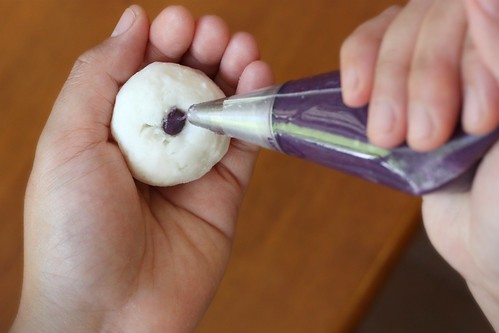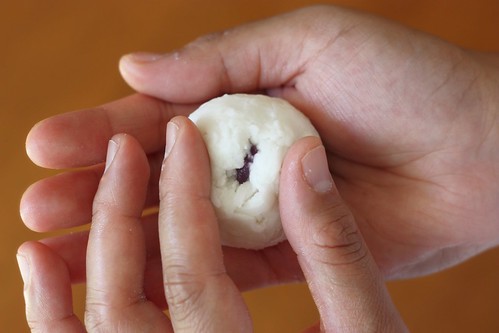

When my friend brought these over a few weeks ago, I said something that I wished I didn't. "I wish I knew how to make karioka. Nope. Strike that. I'm gonna learn how to make karioka!" Before I knew it, I was searching online for recipes, adjusting a few ingredients to fit my liking and cooking up a batch of my own homemade karioka. After I took my first bite, I knew I was in big trouble...

They were absolutely delicious! I couldn't stop eating them and the same goes for my non-dessert eating husband. "See [as he takes a bite of karioka], this is why I can never lose weight." LOL Which brings me back to why I wish I didn't say, "I'm gonna learn how to make karioka!" It's become an instant family favorite and I'm probably gonna be making a lot these quite often (maybe even tomorrow).

So what exactly is karioka? It's basically a deep-fried dough that's dipped in a sweet glaze...like a cross between a Spanish churro and a Japanese mochi. I guess you can say it's the Filipino version of a donut hole. It's also known as kaskaron or bitsu-bitsu, depending on what region of the Philippines you're from. When you bite into one, you get the sweetness from the brown sugar glaze, then the crunchiness from the crispy outside and finally the chewiness of the coconut rice ball inside. Sweet. Crunchy. Chewy. PERFECT! It's a popular street food in the Philippines and it's usually sold alongside other deep-fried sweets like turon (bananas and jackfruit inside a lumpia wrapper), banana cue (bananas with caramelized brown sugar) and kamote cue (sweet potato with caramelized brown sugar).

I remember when I was a little girl, I used to buy my afterschool snacks from the street vendors that would line up outside my school. I'd buy things like sorbetes (dirty ice cream), banana cue, fresh sugar cane, singkamas or mangga with bagoong (jicama or green mangoes with shrimp paste) and fish balls dipped in all three sauces (yeah). My mom didn't exactly like the idea of me eating street food, so I made sure I finished all my snacks in the jeepney before I got home. Strangely enough, I don't think I ever tried karioka until I arrived here in the United States. Well, that's a shame.

What I love about karioka (besides eating them, of course) is that they are so easy to make. It's ridiculous! I mean, all you need is four ingredients: sweet rice flour, flaked coconut, coconut milk and brown sugar. Well, five if you count the vegetable oil. Okay then, five ingredients. Just mix them together, deep-fry them and glaze them. That's it! Now why haven't I tried to learn how to make these sooner?


Well, after making karioka and absolutely loving it, I thought I'd get a little creative and add some filling inside. It's kind of an idea a borrowed from another dessert called butsi (or buchi). They're sesame seed balls filled with red bean paste. I figured it would be interesting to do the same for karioka but instead of red bean paste, I wanted to try some traditional Filipino flavors.

I picked up some canned langka (jack fruit), ube (purple yam) and macapuno (gelatinous mutant coconut). All of these are available in Filipino or Asian supermarkets. Jack fruit is a tropical fruit that's typically eaten fresh in the Philippines, but here in the United States, you can most likely find them canned in syrup. Ube and macapuno are commonly used to flavor ice cream or used as filling for desserts.

Out of the three choices, the first one I tried was the ube filling. I used a piping bag to pipe the filling into the center. I pinched the dough to seal the filling inside and gently rerolled it into a ball.

It actually turned out pretty good. The filling stayed in the center and when I bit into the karioka, I got a nice ube flavor inside. I might wanna try this again but with my aunt's recipe for ube halaya, which is thicker and richer than the ube in a jar.

The next one I tried was the jack fruit. I chopped it up into small pieces and put about 1/2 teaspoon of it inside the karioka. THIS is definitely a winner! The flavors of the coconut and jack fruit just worked so well together. I've gotta make these again soon :-)

The last one I tried was the macapuno and it didn't do so well (which explains why I don't have a photo of it). Maybe it was a textural thing or the macapuno had too much liquid. It just tasted soggy in the middle. And the macapuno flavor just faded away into the background. That's too bad. I really like macapuno, just didn't work with karioka I guess. Well, two out of three ain't so bad.
I have a feeling I'll be making a lot of these for my next summer get-together. Fourth of July maybe? Hmmmm...
Karioka
Adapted from Panlasang Pinoy
Makes about 24 pieces
dough:
2 cups Mochiko sweet rice flour
2 cups sweetened flaked coconut
1 1/2 cups coconut milk
3 cups vegetable oil
glaze:
1 cup light brown sugar
1/4 cup coconut milk
optional fillings:
ube (purple yam)
langka (jackfruit), chopped
macapuno (gelatinous mutant coconut), chopped
bamboo skewers
In a mixing bowl, combine sweet rice flour, flaked coconut and coconut milk. Take two tablespoons of the dough and shape into a ball. Set aside. (If adding filling, poke a hole in the ball and add about 1/4 to 1/2 teaspoon of filling inside then gently close up the hole and reshape the dough into a ball)
Heat up the oil in a wok or deep pan to medium-high heat. (Tip: one way to test if the oil is hot enough is by dropping a small piece of dough into the oil. If the dough starts bubbling right away, then the oil is hot enough. If the dough bubbles slowly or you don't see any bubbles at all, then oil isn't hot enough). Cook the balls for about 5 to 7 minutes or until golden brown. Transfer the cooked karioka onto a plate lined with paper towels to soak up the excess oil. Set aside.
In a medium sauce pan, combine brown sugar and coconut milk. Bring to a boil and then remove from heat. Dip the karioka in the brown sugar glaze until completely coated. Carefully place four of the karioka into each bamboo skewer. Serve immediately.
Please note: I am not a paid endorser nor did I accept any freebies of the brands or products mentioned in this post. I just love them and want to share it with you :-)

19 comments:
GURU! You are genius! Make sure you keep these recipes going, honor our LOLAs and our memories.
I always make these and I just use glutinous rice glour minus the coconut. I haven't heard of these having coconut on the inside but I'm defenitely gonna try it! And the filling idea is genius!!
http://www.whatmaewears.blogspot.com
OMG!! I LOVE THESE! Thanks for the recipe, I may try to make them this weekend!!! Mahalo!
I have never seen anything like this before, but I love the look of it and the inclusion of jackfruit. Thanks for posting this. I look forward to making it in the future and reading more of your posts.
These look absolutely delicious! Will have to give them a try in the next few weeks xx
Looks tooo goood! Coconut has been my favorite flavor lately, and I like how these use rice flour. Might try soon!
About to make these right now :)
That looks awesome...I was just browsing through foodgawker when I stumbled upon your dish...Great!
I will serve this delish dessert at the Filipino Festival.
Thanks
These look so yummy! The pics of them open showing the filling remind me of Italian arancini. I've got a batch of your egg-free brownies cooling at the moment after finding your blog this morning. Hope you're having a good day and thanks for the recipes :-)
I've made buchi before and karioka (following my mom's excellent recipe) but never have seen karioka with filling before. Sounds like something I'll try!
do u know what restaurants have that
i had tried making this a year ago, hoping i can make it by myself but ended up in accident. hot oil explodes in my wrist(a 2nd degree burn) aww. i didn't put any filling. what went wrong? this is my fav dessert but i dont want that to happen again. any suggestion? thanks!
Wow, you just brought me back to my childhood back home in the Phil. I remember buying these from street vendors after school on our way home. Thanks for the fond memories and the recipe.
I just made this recipe,and while my parents really enjoyed this, i thought it was okay, but yummy. It was just a bit too dense for me. I like the karioka more light and fluffy, maybe next time i will leave out the coconut flakes. Other than that, good recipe.
Hi Rianne, thanks for posting this recipe. I will definitely ask my mom to try to cook this one. Btw, I mention your blog on one of my posts (justonebigman.blogspot.com). I hope it's fine with you. Thanks again and happy eating!
May I know if the coating of sugar and coconut syrup remained wet or does it dry up eventually? If not I may just use regular caramel coating like the one we put in yemas. Thanks.
Elajr: Yes it does harden and crystallize eventually. I took this picture while it was drying. If you're looking for a clear candy shell like in yemas, you need to use a caramelized sugar recipe (granulated sugar, lemon juice and a little water to brush the sides of the pan while the sugar is melting)
I usually get my karioka from my local asian food store, but now that I have a recipe (that includes jackfruit, no less!), you can bet I'll be making these all the time now. Thank you so much.
Post a Comment